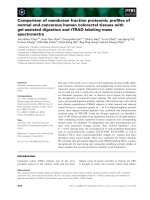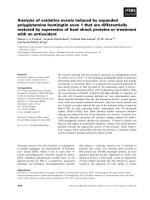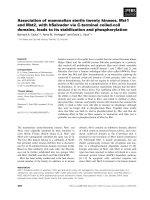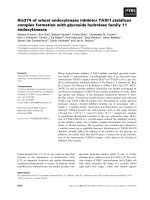Báo cáo khoa học: "Grafting of oaks with variegated" pdf
Bạn đang xem bản rút gọn của tài liệu. Xem và tải ngay bản đầy đủ của tài liệu tại đây (455.14 KB, 5 trang )
Original
article
Grafting
of
oaks
with
variegated
leaves
Z
Borzan
Faculty
of
Forestry,
Department
of
Forest
Genetics
and
Dendrology,
41001
Zagreb,
PO
Box
178,
Croatia
Summary —
Among
1-year
Quercus
robur
L
seedlings,
several
plants
were
selected,
differing
from
others
in
the
population
by
their
variegated
leaves.
Such
plants
could
be
useful
in
arboriculture,
if
we
could
fix
the
appearance
of
variegated
leaves
and
solve
the
problems
of
vegetative
propagation.
This
paper
discusses
the
cytoplasmic
inheritance
of
oak
leaf
variegation
and
describes
the
methods
of
grafting.
Grafting
and
callusing
of
grafts
in
a
mixture
of
sawdust
and
moss
enables
the
production
of
an
average
of
32%
firmly
joined
grafts
at
the
end
of
the
first
growing
season.
Quercus
robur
L
/ leaf
variegation
/
vegetative
propagation
Résumé —
Greffage
de
chênes
aux
feuilles
bigarrées.
Plusieurs
plants
d’un
an
de
Quercus
robur
L
présentant
des
feuilles
bigarrées
ont
été
sélectionnés.
Ces
plants
pourraient
être
utilisés
en
horti-
culture,
si
les
problèmes
de
fixation
du
caractère
bigarré
et
de
multiplication
végétative
sont
résolus.
Cet
article
discute
de
l’hérédité
cytoplasmique
du
caractère
bigarré
et
présente
une
méthode
de
greffage.
Le
greffage
et
la
cicatrisation
de
la
greffe
dans
un
mélange
de
sciure
et
de
mousse
per-
mettent
d’obtenir
32%
de
greffes
fermement
adhérentes
aux
porte-greffes
à
la
fin
de
la
première
sai-
son
de
végétation.
Quercus
robur L
/ feuilles
bigarrées
/ multiplication
végétative
INTRODUCTION
Among
the
numerous
pedunculate
oak
seedlings
in
our
nurseries,
individual
spec-
imens
with
differently
variegated
leaves
are
noticeable.
We
have
selected
50
genotypes
since
1987,
with
the
aims
of
monitoring
foliar
changes
throughout
the
season
and
propagating
the
best
variants
by
the
device
grafting
method
used
by
Borzan
and
Littvay
(1989).
In
addition
to
our
own
selected
oaks,
we
have
collected
variegated
samples
from
the
Kilmacurragh
Institute
in
Ireland.
This
paper
discusses
the
foliar
variegation
of
pedunculate
oak
leaves
based
on
the
available
literature
and
presents
the
results
of
their
vegetative
propagation.
MATERIALS
AND
METHODS
The
behavior
of
figurative
patterns
of
foliar
var-
iegation
of
50
selected
pedunculate
oak
seed-
lings
has
been
monitored
in
the
nursery
since
1987.
Scions
from
5
of
our
own
oaks
and
4
from
trees
at
the
Kilmacurragh
Institute
in
Ireland
(ta-
ble
I)
were
kept
in
the
refrigerator
(+
5
°C)
and
grafted.
Grafting
was
carried
out
in
March
1991,
using
a
home made
grafting
device
fixed
to
a
ta-
ble
and
powered
manually.
The
device
cut
a
groove
on
the
root-stock
and
a
cog
on
the
scion
in
the
shape
of
the
Greek
letter
Ω
(fig
1).
Joined
root-stocks
and
scions
were
kept
for
14
days
in
a
box
completely
covered
by
a
mixture
of
wet,
fine
and
coarse
sawdust
(75%)
and
moss
(25%)
at
a
stable
temperature
of
27
°C
and
an
air
hu-
midity
of
70-80%.
After
14
days,
the
callused
and
flushed
grafts
were
taken
out,
planted
in
containers,
put
in
the
shade
in
a
heated
plastic
house
and
protected
both
from
spring
frosts
and
strong
sunlight.
The
remaining
grafts
were
re-
turned
for
further
callusing
for
another
7
days.
RESULTS
Among
50
selected
1-year-old
seedlings
with
differently
variegated
leaves
in
the
course
of
the
2nd
and
3rd
year,
some
of
them
changed
to
green
leaves,
indicating
a
loss
of
variegation.
A
small
number
of
plants
(5)
showed
the
same
type
of
variegation
on
all
leaves
both
in
the
2nd and
3rd
year
(fig
2a,
b,
c).
Two
of
them
had
second-flush
leaves
with
larger
variegated
surfaces
(fig
2b,
c),
thus
differing
from
those
of
the
first
flush.
Most
of
the
plants
(20)
remained
varie-
gated
in
the
second and
subsequent
years
but
with
only
occasional
variegation
of
their
leaves.
Some
produced
green
leaves
in
the
first
flush
and
variegated
ones
in
the
second
(fig
2d),
while
others
did
the
oppo-
site.
Among
the
latter
group,
1
plant
pro-
duced
only
white
leaves
in
the
first
flush
and
green
in
the
second.
Soon
after
the
appearance
of
green
leaves
on
that
plant,
the
white
leaves
fell,
after
becoming
brownish.
One
of
the
5-year-old
plants
had
a
strongly
variegated
side
branch
though
no
variegated
leaves
occurred
on
the
main
stem.
The
variegated
branch
also
had
a
certain
number
of
completely
green
leaves.
Generally,
the
spring
types
of
variega-
tion
are
more
attractive
than
the
summer
ones,
showing
brighter
white
and
yellow
colors.
In
summer,
individual
variegated
parts
of
the
spring
leaves
dry,
especially
if
the
plants
are
exposed
to
the
sun.
Table
I shows
the
results
of
grafting.
Out
of
the
113
plants
grafted
on
27
March
1991,
36
had
developed
normally
by
mid-
August,
ie,
32%
were
considered
fairly
successful.
Grafting
success
depended
primarily
upon
the
thickness
of
the
scion,
because
it
is
much
easier
to
perform
regular
"omega"
cuts
on
thicker
scions.
The
plants
with
short
and
thin
shoots
gave
poorer
results.
Some
grafted
genotypes
that
were
expect-
ed
to
have
variegated
leaves
produced
only
green
leaves
throughout
the
season.
These
results
support
our
previous
find-
ings
(Borzan
and
Littvay,
1989)
when
we
concluded
that
it
was
possible
to
graft
pe-
dunculate
oak
successfully
and
to
recom-
mend
device
grafting
as
a
simple
and
low-
cost
method.
DISCUSSION
Variegation
was
defined
by
Schultz
(1936)
(quoted
by
Rieger
et
al,
1976)
as
"
the
occurrence,
within
one
tissue,
organ,
or
in-
dividual,
of
a
mosaic
phenotype
with
re-
spect
to
pigmentation
It
is
a
widespread
phenomenon
caused
by
several
(observed
or
inferred)
mechanisms:
1.
Plastid
varia-
tion
and
the
behavior
of
plastid
variants
in
somatic
divisions
of
plants;
2.
Genic
insta-
bility
and
the
recurrence
of
somatic
muta-
tions;
3.
Instability
of
the
phenotypic
ex-
pression
of
genes
as
a
result
of
position
effect;
4.
Genetically
controlled
stickiness
of
chromosomes;
5.
Somatic
crossing-
over;
6.
Somatic
behavior
of
ring
chromo-
somes
and
dicentric
chromosomes;
7.
In-
fection".
All
of
these
causes
of
oak
leaf
variega-
tions
are
probably
present
in
our
plants,
except
the
last.
Variegated
oaks
change
rapidly
up
to
the
age
of
3
years.
Usually,
after
the
3rd
year,
their
variegated
features
become
increasingly
stable,
while
the
sort-
ing
of
mutated
plastids
is
very
intensive
during
the
first
3
years,
resulting
in
some
plants
eventually
having
only
green
leaves.
However,
the
heritable
properties
of
the
plastids
(the
sum
total
of
the
extrachromo-
somal
genetic
information
is
defined
as
plastom,
after
Renner
(1929,
1934)
(cited
in
Rieger
et
al,
1976)
ie,
their
ability
to
mu-
tate
and
to
multiply
are
of
importance
for
the
expression
of
variegation.
Tilney-
Bassett
(1963)
considers
variegated
plants
to
be
chimeras.
We
have
observed
2
main
kinds
of
fo-
liar
variegations
among
selected
peduncu-
late
oak
seedlings.
Stable
variegations
(fig
2a,
b,
c)
which
are
most
probably
controlled
by
nuclear
genes,
causing
mutations
of
2
kinds.
First,
those
with
variegated
leaves,
produced
at
each
flush,
having
different
shades
of
green,
yellow,
cream
or
white
or
combina-
tions
of
these
colors
evenly
distributed
through
the
whole
leaf
(fig
2a).
Such
fea-
tures
resemble
the
foliar
variegation
of
Dieffenbachia
maculata
cultivars
Perfec-
tion
and
Hoffmannii,
for
which
Henny
(1982)
concluded
that
their
foliar
variega-
tion
is
under
the
control
of
a
single
domi-
nant
nuclear
gene.
This
assumption
can
only
be
proved
after
spontaneous
or
in-
duced
flowering
of
these
variegated
oak
seedlings,
when
it
is
possible
to
perform
controlled
crossing.
Second,
those
with
foliar
variegations
produced
at
each
flush
(fig
2b,
c),
with
the
leaves
of
the
first
flush
having
a
different
type
of
variegation
than
those
of
the
sec-
ond.
Stable
variegations
are
most
desirable,
because
of
their
beauty
and
promise
for
tree
improvement
work.
The
slower
growth
of
our
specimens
of
this
kind
is,
at
the
mo-
ment,
a
disadvantage
because
at
5
years
they
are
still
too
small
to
be
grafted.
Occasionally
variegated
oaks
can
also
be
divided
into
two
groups.
First,
those
with
green
leaves
on
the
first
flush
and
var-
iegated
ones
on
the
second,
or
vice
versa.
Variegation
of
this
type
is
quite
stable,
ie,
foliar
variegation
appears
every
year
only
on
the
first-flush
leaves
or
only
on
the
second
flush
leaves.
The
extent
of
the
variegation
on
branches
varies.
Thus,
it
is
advisable
to
mark
the
branches
with
attrac-
tive
and
extended
leaf
variegation
during
a
season
and
to
use
them
as
scions
the
fol-
lowing
spring,
to
assure
a
greater
quantity
of
mutated
plastids
in
grafted
plants.
The
nature
of
this
type
of
variegation
is
not
clear
at
the
moment.
It
is
probably
caused
by
nuclear
gene-induced
plastom
mutation
with
increased
variegation
fre-
quency
only
at
a
certain
time
during
the
season
(ie,
only
in
a
certain
tissue
layer
of
cells),
for
variegation
appears
repeatedly
at
a
particular
time
during
the
growing
sea-
son,
while
during
the
rest
of
the
season
the
plant
flushes
with
only
green
leaves.
Second,
occasionally
variegated
oaks
can
have
foliar
variegation
as
sports.
Var-
iegation
of
this
type
could
be
lost.
Such
plants
have
several
features.
At
least
during
the
first
part
of
the
season,
variegated
leaves
have
large,
nicely
colored
yellow-
green
or
white-green
patterns
which
may
appear
every
year
and
remain
stable.
Of-
ten,
white
or
yellow
leaf
parts
shrivel
and
burn
in
full
sun.
It
is
advisable
to
raise
them
in
half
shade.
However,
sports
are
interest-
ing
for
possible
vegetative
propagation.
Occasionally
variegated
oaks
grow
fast-
er
than
those
with
stable
variegated
leaves.
REFERENCES
Borzan
&jadnr;,
Littvay
T
(1989)
Vegetativno
razmnoz-
avanje
hrasta
luznjaka
strojnim
cijepljenjem.
Sumarski
list
113,
557-566
Henny
RJ
(1982)
Inheritance
of
foliar
variega-
tion
in
two
Dieffenbachia
cultivars.
J Hered
73, 384
Rieger
R,
Michaelis
A,
Green
MM
(1976)
Glos-
sary
of
Genetics
and
Cytogenetics,
Classical
and Molecular.
Springer-Verlag,
Berlin
Tilney-Bassett
RAE
(1963)
The
structure
of
peri-
clinal
chimeras.
Heredity
18, 265-285









